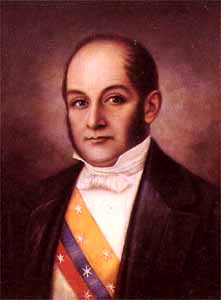José de Obaldía facts for kids
Quick facts for kids
José de Obaldía y Orejuela
|
|
|---|---|
 |
|
| 7th Vice President of New Granada | |
| In office 1 April 1851 – 1 April 1855 |
|
| President | José Hilario López Valdéz (1851—1853) José María Obando del Campo (1853—1854) None (1854—1855) |
| Preceded by | Rufino Cuervo y Barreto |
| Succeeded by | Manuel María Mallarino Ibargüen |
| Personal details | |
| Born | 19 July 1806 Santiago, Panama, Viceroyalty of the New Granada |
| Died | 28 December 1889 (aged 83) David, Panama, Colombia |
| Nationality | Colombian |
| Political party | Liberal |
| Spouse | Ana María Gallegos Candanedo (1842—1889) |
| Children |
José Arístides de Obaldía Gallegos |
| Alma mater | National University of Colombia |
| Profession | Lawyer |
José de Obaldía y Orejuela (born July 19, 1806 – died December 28, 1889) was an important leader in the country once known as New Granada. He served as the 7th Vice President and even became the Acting President on two different occasions.
Contents
Early Life and Family
José de Obaldía was born on July 19, 1806, in a place called Santiago de Veraguas. At that time, this area was part of the Viceroyalty of the New Granada. His father, Domingo Blas de Obaldía y Latatu, was from Spain. His mother, Juana María de Orejuela Cordero, was a Criollo, meaning she was of Spanish descent but born in the Americas.
In 1842, José de Obaldía married Ana María Gallegos Candanedo. They had four children together. Their names were José Arístides, José Domingo, José Lorenzo, and Ana Josefa. Sadly, José Lorenzo and Ana Josefa passed away when they were very young.
Serving as Vice President (1851–1855)
José de Obaldía was chosen as Vice President in 1851. He became the 7th Vice President of New Granada. He started his term on April 1, 1851, working with President José Hilario López Valdéz.
Taking Charge as Acting President
From October 14, 1851, to January 21, 1852, Vice President Obaldía took on the role of acting president. This happened while President López was away from the capital city. He was in charge of the country's executive power during this time.
On April 1, 1853, José María Obando del Campo became the new President. Even though there was a new president, Obaldía stayed as Vice President. This was because the elections for president and vice president were held at different times.
Political Differences and Challenges
Both President Obando and Vice President Obaldía were members of the Liberal party. However, they had different ideas about how the country should be run. Obando belonged to a group called the Draconian faction. This group was practical but supported things like the death penalty. Obaldía was part of the Golgothian faction. This group was more radical and wanted many reforms.
Because of these different ideas, Obando and Obaldía often disagreed. The Golgothians had not wanted Obando to become president in the first place.
The Coup and Government in Exile
In April 1854, the Golgothians in Congress tried to make the army smaller and less powerful. This action led to a sudden takeover, known as a coup. General José María Melo y Ortiz, who was in charge of the army in Bogotá, led this coup. General Melo hoped that President Obando would support him and stop Congress.
But President Obando refused to go along with the coup. So, General Melo took over the presidency himself and started a dictatorship. He even put President Obando in prison. Vice President Obaldía managed to escape. He found safety at the US Legation in Bogotá, which was led by James S. Green, the US representative.
Obaldía and other leaders who were against Melo's dictatorship met in a city called Ibagué. They formed a government-in-exile there. This means they acted as the official government even though they were not in the capital. They also started a military campaign to remove Melo from power.
Return to Power
On September 22, the Congress met in Ibagué. They decided that President Obando had been careless and had not stopped the coup. So, they officially removed him from office. On August 5, Vice President Obaldía, who had spoken against Obando, was put in charge of the executive power. He became the acting president of the government that was fighting against Melo's dictatorship.
On December 4, the forces fighting for the constitution marched into Bogotá. They removed Melo from power. Vice President Obaldía then became the acting president of the constitutional government. His term as Vice President ended on April 1, 1855. After him, Manuel María Mallarino Ibargüen, a Conservative Congressman, was chosen to be the new Vice President and finish Obando's term as acting president.
See also

- In Spanish: José de Obaldía para niños

